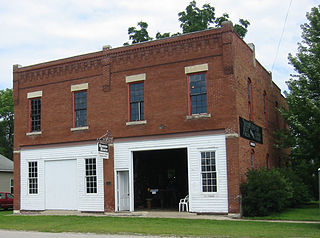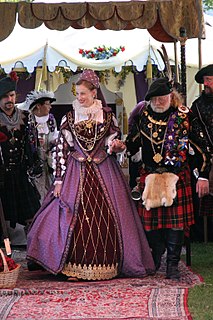
The Streibich Blacksmith Shop is a historic blacksmith shop located at 1 N. Howard St. in Newman, Illinois. The shop was built in 1870 for local blacksmith Ignatius Streibich. Streibich's shop produced farming equipment and domestic items for residents of the area. In addition, Streibich started the first electric power plant in Douglas County in the shop in 1891. While the power plant only lasted a year, it provided a model for future electification efforts in Newman. Streibich retired in 1912, and his son Fred purchased the shop in 1916. Fred Streibich operated the blacksmith shop until his death in 1932. Machinist Kermit O. Tucker operated a shop in the building from 1938 to 1969.

Fort Omaha, originally known as Sherman Barracks and then Omaha Barracks, is an Indian War-era United States Army supply installation. Located at 5730 North 30th Street, with the entrance at North 30th and Fort Streets in modern-day North Omaha, Nebraska, the facility is primarily occupied by Metropolitan Community College. A Navy Operational Support Center and Marine Corps Reserve unit, along with an Army Reserve unit occupy the periphery of the 82.5 acres (33.4 ha) fort. The government deeded all but four parcels of the land to the community college in 1974.

Sugartown is an unincorporated settlement in central Willistown Township, Chester County, Pennsylvania, United States, at the intersection of Sugartown and Boot Roads. It is located 18 miles west of Philadelphia.

The Notre Dame Academy and Convent is located at 3501 State Street in the Florence neighborhood on the north end of Omaha, Nebraska. It is significant for its ethnic association with the Czech population in Nebraska as the only school and convent of the Czechoslovakian School Sisters de Notre Dame in the United States. The building was listed on the National Register of Historic Places in 1998. The groups were home to a high school for girls from 1925 through 1974.

The Georgia State Railroad Museum is a museum in Savannah, Georgia located at a historic Central of Georgia Railroad site. It includes parts of the Central of Georgia Railroad: Savannah Shops and Terminal Facilities National Historic Landmark District. The complex is considered the most complete antebellum railroad complex in the United States. The museum, located at 655 Louisville Road, is part of a historic district included in the National Register of Historic Places.

The O. C. Barber Machine Barn, also called the Implement House. built in 1911, is an historic farm building located on Austin Drive on the Anna-Dean Farm in Barberton, Ohio. It was built by American businessman and industrialist Ohio Columbus Barber, the developer of both Barberton, which he envisioned as a planned industrial community, and the nearby 3,500-acre (14 km²) Anna-Dean Farm, which he envisioned as a prototype for modern agricultural enterprise. Barber was called America's Match King because of his controlling interest in the Diamond Match Company.

This is a list of the National Register of Historic Places listings in Cook County, Minnesota. It is intended to be a complete list of the properties and districts on the National Register of Historic Places in Cook County, Minnesota, United States. The locations of National Register properties and districts for which the latitude and longitude coordinates are included below, may be seen in an online map.

This is a list of the National Register of Historic Places listings in Knox County, Nebraska.

The El Tovar Stables at the south rim of the Grand Canyon were built about 1904, at the same time the nearby El Tovar Hotel was built, to house the animals used in general transportation around the park. Collectively called the "transportation department" in the early 20th century, the three structures comprised a horse barn or stable, a mule barn and a blacksmith shop.

Brown-Moore Blacksmith Shop is a historic blacksmith shop located at Luzerne Township, Fayette County, Pennsylvania. The shop began operation in 1822, and remained open until 1939. It is a rectangular brick building with a corrugated metal roof. It has a rectangular wood frame wagon shop addition rebuilt in 1919 after a fire. The shop has two large stone, hand-operated forges.

Quasdorf Blacksmith and Wagon Shop, now known as the Quasdorf Blacksmith and Wagon Museum, is an historic building located in Dows, Iowa, United States. The shop was built in 1899 and remained in continuous use until 1990 when Frank Quasdorf willed the building to the Dows Historical Society. The building was restored and reopened as a museum. Displays include machines, tools, belt-driven and electric welding equipment, original wagon wheels, blacksmithing items, a forge and the bellows. Many of the items on display are original to the building and the Quasdorf family.

Hickman Blacksmith Shop and House, also known as the Chas. C. Connell Roofing, Gutter, and Siding Co. and Jeffrey and Pamella Seemans House, is a historic home and blacksmith shop located at Marshallton, New Castle County, Delaware. The shop was built about 1899, and is a rectangular, frame, 1 1/2-story building on a high stone foundation. The house was built about 1860, and is a side-passage plan, frame, 2-story dwelling on a stone foundation, with Stick trim and modest interior finish.

The Chandler-Parsons Blacksmith Shop, now the Blacksmith Shop Museum, is a historic blacksmith shop at 107 Dawes Road in Dover-Foxcroft, Maine. Believed to be built in the early 1860s, it is one of a very small number of relatively unaltered rural 19th-century blacksmithies in the state. It is owned and operated by the local historical society as a museum, and was listed on the National Register of Historic Places in 1989.

The Bigler Building, also known as the Riegel Blacksmith Shop, is a historic building located in Clermont, Iowa, United States. The simple, single-story brick structure was built in about 1906 by Fred Bigler who operated the local lumberyard and was a contractor. This property had long been the location for a blacksmith shop. Burkhard Riegel, a German immigrant, opened his shop in this building in 1931. He rented the space until he bought the building from Bigler's widow in 1946. After his death in 1990, the Clermont Historical Society acquired the building for a living history museum, and it contains its original blacksmithing equipment and furnishings. It was listed on the National Register of Historic Places on June 9, 1995.

The Ponca Historic District is a historic district in Ponca, Nebraska that was listed on the National Register of Historic Places in 1979. It includes the commercial center of Ponca, including 38 contributing buildings.

The Dixon County Courthouse in Ponca, Nebraska was built in 1883-84 and expanded in 1939-1940. It was listed on the National Register of Historic Places in 1990.

The Ponca Tribal Self-Help Community Building Historic District, with the Ponca Agency Building, was listed on the National Register of Historic Places in 2003.

The Ponca Creek Bridge, also known as NEHBS No. BD00-224, is a historic Pratt truss bridge spanning Ponca Creek that is listed on the National Register of Historic Places.

The Red Ball Garage, also known as the Ed Neil Garage, is a historic building located in Swedesburg, Iowa, United States. The building is located along what was known as the Military Road. Because of the marshy land in the area, wagons and buggies had to be pulled out of the mud. In 1913 the road became a part of the Red Ball Route, a highway that linked the Minneapolis/St. Paul area with St. Louis. It received its named from the highway signs used to mark the route. The highway was paved from 1929 to 1930, and later became U.S. Route 218 until it was moved to the east as a four lane-highway in the 1990s.
























